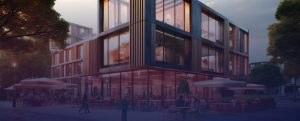How is Southeast CRE Holding Up?
To ride out the uncertainty of interest rates and rising costs, investors are placing their capital in durable commercial real estate assets in top-performing markets with excellent fundamentals and growing populations. The Southeast is on the receiving end of investor interest, boasting robust industrial pipelines, historically high multifamily rent growth, shopping center redevelopment trends, and high price-per-square foot retail prices.

Net Lease Retail
Nationally, net lease retail is performing well, with record leasing, rent growth, and development in major markets. Retailers tend to follow population trends and set up shops in locations with heavy foot traffic or solid fundamentals. From 2010 to 2020, Nashville’s population grew 21 percent to two million people, according to U.S. Census Bureau data. That’s why convenience store chain Wawa has targeted Nashville for aggressive expansion, with plans to open 40 locations in Music City.
Shopping Centers
By now, it’s common knowledge that grocery-anchored shopping centers are a high-performing asset. This sentiment is repeated in the Southeast as investors aggressively target these retail centers as they are confident about leasing prospects for in-line spaces as tenants seek stability. According to CoStar data, $11.5 billion of grocery-anchored centers traded hands in 2021.
Developers target the Southeast for shopping center development specifically for the incredible job growth recorded and ready-to-work states. A Canadian-based grocery retail estate investment trust is also targeting Southeast states, specifically Florida, North Carolina, and Georgia, for their growing populations.
Industrial
Overall, industrial is in high demand in high-growth markets, especially in the Southeast. Retailers looking to optimize last-mile delivery from the surge in e-commerce orders are resulting in record-low vacancies throughout the region. Industrial growth is unprecedented as ramped-up construction is projected to create record deliveries for 2022 and beyond.
Rents are expected to continue to grow as limited availability gives landlords the upper hand to hike rents. Investors are increasingly targeting fully occupied industrial properties with below-market rents and upcoming lease expirations. The buyers see the opportunity to boost the properties’ net operating income without the risk of holding a vacant, non-income-producing asset as leases can be negotiated with existing tenants.
Multifamily
With rental demand reaching record highs, along with rent increases, the Southeast is achieving new accolades each day. Strong in-migration, household formations, and job growth have fed into multifamily demand. Developers follow the migration trends and respond by building out new projects to fulfill housing needs.
Charlotte, North Carolina, has seen construction starts at an all-time high of 5,000 units breaking ground from the end of 2021 through Q1 2022. This has resulted in Charlotte’s largest multifamily pipeline, with almost 20,000 units, or 10.2 percent of existing stock, underway.









